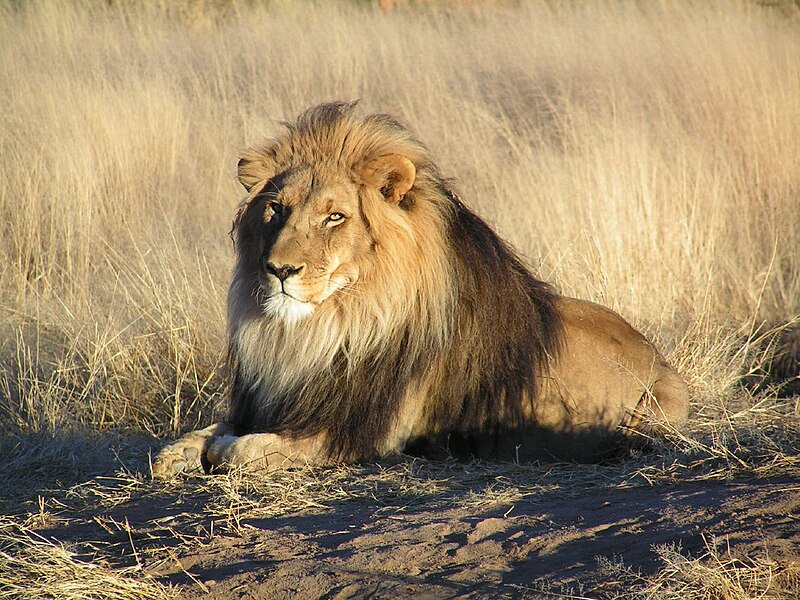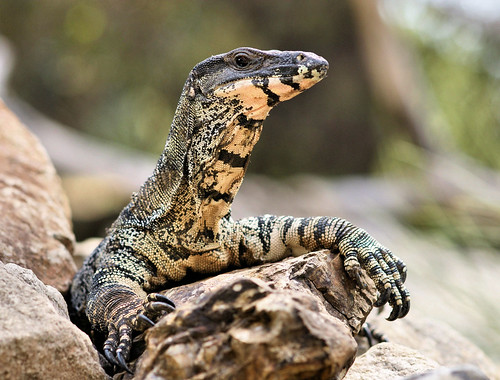Post by Deinobrontornis on Oct 17, 2011 10:51:53 GMT -5
[a href="African Lion - Panthera leo"]African Lion - Panthera leo[/a]

The lion is the tallest (at the shoulder) of all living cats, averaging about 14 cm (5.5 in) taller than the tiger. Behind only the tiger, the lion is the second largest living felid in length and weight. Its skull is very similar to that of the tiger, although the frontal region is usually more depressed and flattened, with a slightly shorter postorbital region. The lion's skull has broader nasal openings than the tiger. However, due to the amount of skull variation in the two species, usually, only the structure of the lower jaw can be used as a reliable indicator of species. Lion coloration varies from light buff to yellowish, reddish, or dark ochraceous brown. The underparts are generally lighter and the tail tuft is black. Lion cubs are born with brown rosettes (spots) on their body, rather like those of a leopard. Although these fade as lions reach adulthood, faint spots often may still be seen on the legs and underparts, particularly on lionesses.
Weights for adult lions range between 150–250 kg (330–550 lb) for males and 120–182 kg (264–400 lb) for females. Nowell and Jackson report average weights of 181 kg for males and 126 kg for females; one male shot near Mount Kenya was weighed at 272 kg (600 lb). Lions tend to vary in size depending on their environment and area, resulting in a wide spread in recorded weights. For instance, lions in southern Africa tend to be about 5 percent heavier than those in East Africa, in general.
Head and body length is 170–250 cm (5 ft 7 in–8 ft 2 in) in males and 140–175 cm (4 ft 7 in – 5 ft 9 in) in females; shoulder height is up to 123 cm (4 ft) in males and as low as 91 cm (3 ft) in females. The tail length is 90–105 cm (2 ft 11 in-3 ft 5 in) in males and 70–100 cm in females (2 ft 4 in-3 ft 3 in). The longest known lion, at nearly 3.6 m (12 ft) in total length, was a black-maned male shot near Mucsso, southern Angola in October 1973; the heaviest lion known in the wild was a man-eater shot in 1936 just outside Hectorspruit in eastern Transvaal, South Africa and weighed 313 kg (690 lb). Lions in captivity tend to be larger than lions in the wild—the heaviest lion on record is a male at Colchester Zoo in England named Simba in 1970, which weighed 375 kg (826 lb). However, the frequently cited maximum head and body length of 250cm fits rather to extinct Pleistocene forms, like the American lion. Accoring to Mazák the average total length of modern lion males is 260 to 270 cm, rarely above 285 cm. The largest reliable confirmed length for a lion was 305-310 cm total length (between pegs), obtained from an animal shot north of Lake Victoria.
[a href="Grizzly Bear - Ursus arctos horribilis"]Grizzly Bear - Ursus arctos horribilis[/a]

The grizzly bear (Ursus arctos horribilis), also known as the silvertip bear, the grizzly, or the North American brown bear, is a subspecies of brown bear (Ursus arctos) that generally lives in the uplands of western North America.
Most adult female grizzlies weigh 130–200 kilograms (290–440 lb), while adult males weigh on average 180–360 kilograms (400–790 lb). The average total length in this subspecies is 198 centimeters (6.5 ft), with an average shoulder height of 102 centimeters (3.35 ft) and hindfoot length of 28 centimeters (11 in). Newborn bears may weigh less than 500 grams (1 lb). In the Yukon River area, mature female grizzlies can weigh as little as 100 kilograms (220 lb). On the other hand, an occasional huge male grizzly has been recorded which greatly exceeds ordinary size, with weights reported up to 680 kilograms (1,500 lb). Although variable from blond to nearly black, grizzly bear fur is typically brown in color with white tips. A pronounced hump appears on their shoulders; the hump is a good way to distinguish a black bear from a brown bear, as black bears do not have this hump.

The lion is the tallest (at the shoulder) of all living cats, averaging about 14 cm (5.5 in) taller than the tiger. Behind only the tiger, the lion is the second largest living felid in length and weight. Its skull is very similar to that of the tiger, although the frontal region is usually more depressed and flattened, with a slightly shorter postorbital region. The lion's skull has broader nasal openings than the tiger. However, due to the amount of skull variation in the two species, usually, only the structure of the lower jaw can be used as a reliable indicator of species. Lion coloration varies from light buff to yellowish, reddish, or dark ochraceous brown. The underparts are generally lighter and the tail tuft is black. Lion cubs are born with brown rosettes (spots) on their body, rather like those of a leopard. Although these fade as lions reach adulthood, faint spots often may still be seen on the legs and underparts, particularly on lionesses.
Weights for adult lions range between 150–250 kg (330–550 lb) for males and 120–182 kg (264–400 lb) for females. Nowell and Jackson report average weights of 181 kg for males and 126 kg for females; one male shot near Mount Kenya was weighed at 272 kg (600 lb). Lions tend to vary in size depending on their environment and area, resulting in a wide spread in recorded weights. For instance, lions in southern Africa tend to be about 5 percent heavier than those in East Africa, in general.
Head and body length is 170–250 cm (5 ft 7 in–8 ft 2 in) in males and 140–175 cm (4 ft 7 in – 5 ft 9 in) in females; shoulder height is up to 123 cm (4 ft) in males and as low as 91 cm (3 ft) in females. The tail length is 90–105 cm (2 ft 11 in-3 ft 5 in) in males and 70–100 cm in females (2 ft 4 in-3 ft 3 in). The longest known lion, at nearly 3.6 m (12 ft) in total length, was a black-maned male shot near Mucsso, southern Angola in October 1973; the heaviest lion known in the wild was a man-eater shot in 1936 just outside Hectorspruit in eastern Transvaal, South Africa and weighed 313 kg (690 lb). Lions in captivity tend to be larger than lions in the wild—the heaviest lion on record is a male at Colchester Zoo in England named Simba in 1970, which weighed 375 kg (826 lb). However, the frequently cited maximum head and body length of 250cm fits rather to extinct Pleistocene forms, like the American lion. Accoring to Mazák the average total length of modern lion males is 260 to 270 cm, rarely above 285 cm. The largest reliable confirmed length for a lion was 305-310 cm total length (between pegs), obtained from an animal shot north of Lake Victoria.
[a href="Grizzly Bear - Ursus arctos horribilis"]Grizzly Bear - Ursus arctos horribilis[/a]

The grizzly bear (Ursus arctos horribilis), also known as the silvertip bear, the grizzly, or the North American brown bear, is a subspecies of brown bear (Ursus arctos) that generally lives in the uplands of western North America.
Most adult female grizzlies weigh 130–200 kilograms (290–440 lb), while adult males weigh on average 180–360 kilograms (400–790 lb). The average total length in this subspecies is 198 centimeters (6.5 ft), with an average shoulder height of 102 centimeters (3.35 ft) and hindfoot length of 28 centimeters (11 in). Newborn bears may weigh less than 500 grams (1 lb). In the Yukon River area, mature female grizzlies can weigh as little as 100 kilograms (220 lb). On the other hand, an occasional huge male grizzly has been recorded which greatly exceeds ordinary size, with weights reported up to 680 kilograms (1,500 lb). Although variable from blond to nearly black, grizzly bear fur is typically brown in color with white tips. A pronounced hump appears on their shoulders; the hump is a good way to distinguish a black bear from a brown bear, as black bears do not have this hump.












